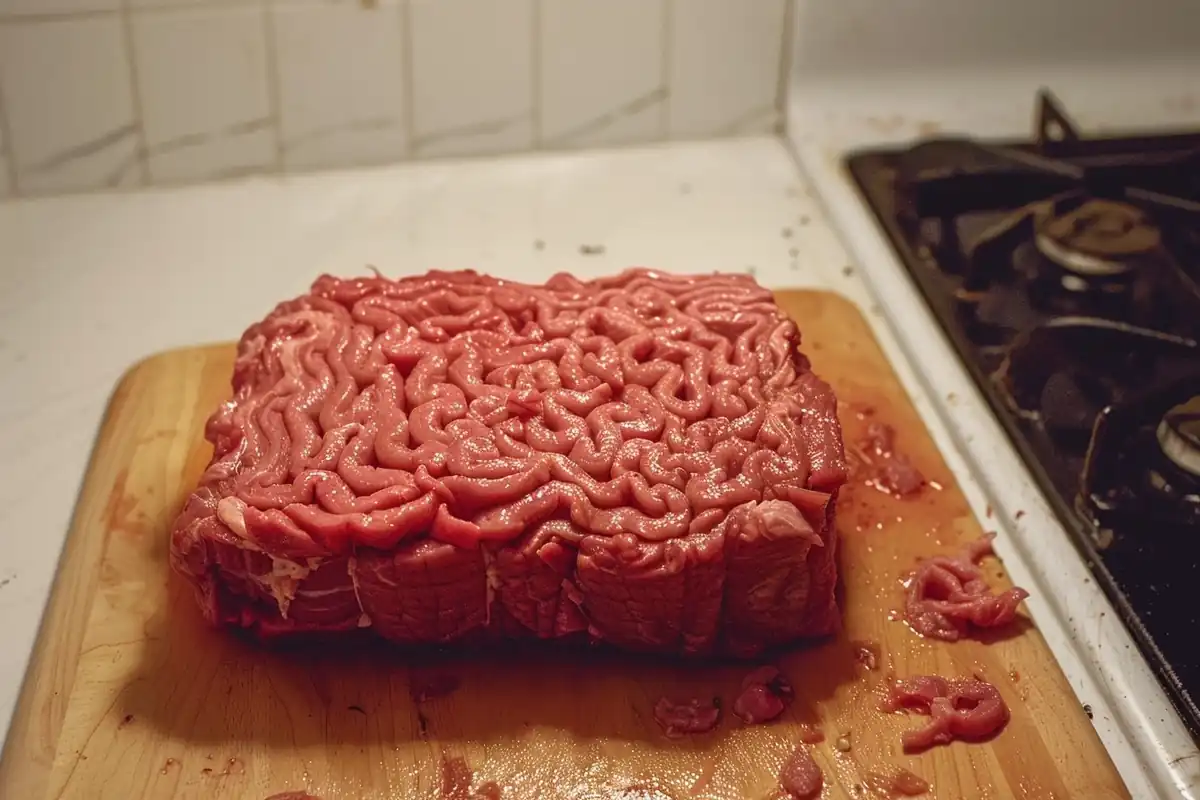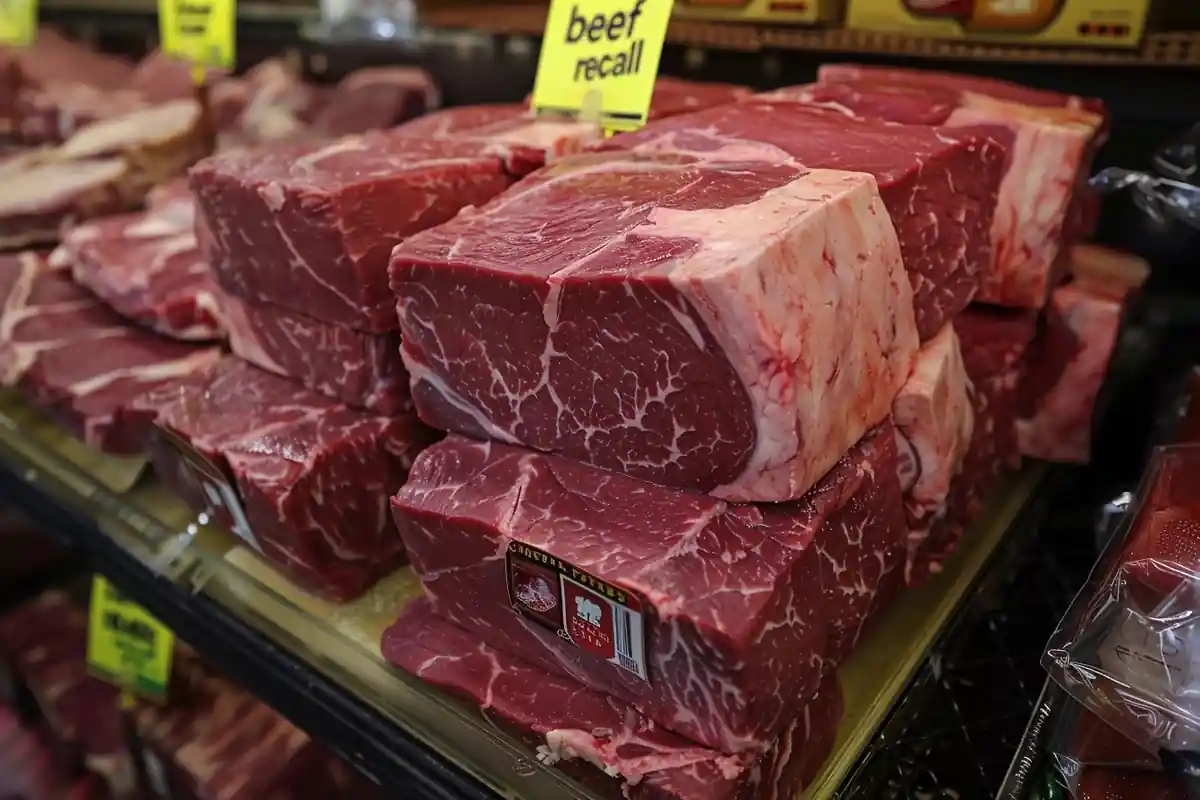This comprehensive guide explains what a beef recall is, how to stay informed about food safety, and what to do if you have affected products.
Understanding Beef Recalls and Food Safety
A beef recall occurs when the USDA or a company determines that a beef product might be unsafe for consumption. Beef recalls are essential actions to protect the public from potentially harmful food. Therefore, it is crucial to understand the causes, process, and implications of a beef recall. This will help consumers stay safe and make well-informed choices regarding the food they purchase. This detailed article will provide practical information and actionable steps related to beef recalls. Consequently, this will enable you to navigate potential risks effectively.
What Triggers a Beef Recall?
Several factors can initiate a beef recall. Pathogen contamination is a primary concern. Indeed, bacteria such as E. coli, Salmonella, and Listeria can cause foodborne illnesses. Therefore, if these pathogens are detected during testing, a recall may be necessary. Moreover, beef recalls may happen because of foreign material contamination. This is when items like metal, plastic, or glass pieces end up in beef during production. Consequently, this can present a physical hazard to consumers. Furthermore, improper handling during production or processing can also contribute. For example, inadequate temperature control can lead to bacterial growth. Therefore, a recall can occur if the product does not meet safety standards. Overall, numerous factors can result in a beef recall, making it essential for consumers to be informed and vigilant.
Common Causes of Beef Recalls
-
Pathogen Contamination: E. coli, Salmonella, and Listeria are frequent culprits. Consequently, these bacteria are known for causing foodborne illnesses.
-
Foreign Material: Contamination by metal, plastic, or other objects can cause harm. Therefore, these situations often lead to recalls.
-
Improper Handling: Issues like incorrect temperatures can encourage bacterial growth. Therefore, this increases the potential for food poisoning.
The Beef Recall Process: How It Works
The beef recall process involves several steps to ensure unsafe products are removed from the market. First, when an issue is identified, the company or the USDA’s Food Safety and Inspection Service (FSIS) starts an investigation. This involves testing to confirm the contamination and its scope. Next, if a recall is deemed necessary, the FSIS issues a public notification. This notice includes detailed information like the product name, lot numbers, and sell-by dates. Therefore, consumers need to pay close attention to this information. Moreover, the company must then take measures to remove the recalled beef from store shelves. They work with distributors and retailers to stop further sales. Finally, consumers must also participate by checking their beef against the recall notice. If you have recalled product, return it to the store or discard it correctly. The goal of the beef recall process is to protect consumers from any health hazards.
Key Stages of a Beef Recall
-
Investigation: Initial examination to confirm the issue. Therefore, this step is crucial for an informed decision.
-
Public Notification: The FSIS or the company issues a recall alert. Consequently, this keeps consumers informed about the problem.
-
Product Removal: Retailers remove affected beef from shelves. Thus, they prevent the further purchase of dangerous products.
-
Consumer Action: Consumers must verify their products. Accordingly, returning them if necessary to protect their health.
How to Stay Informed About Beef Recalls
Staying informed about beef recalls is vital for your health and safety. There are many ways to get reliable updates on beef recalls. For example, you can sign up for email notifications from the FSIS. Similarly, their website also provides updates on current beef recalls. Therefore, it is wise to check these resources frequently. Moreover, many consumer advocacy groups and food safety websites also publish beef recall information. So, it’s useful to consult various sources to stay fully informed. Additionally, news media often report major beef recalls. Following these sources will allow you to receive the latest updates. Finally, consider monitoring the social media accounts of both food safety agencies and the producers of the beef you buy. Therefore, using different types of resources helps you receive timely and complete information on beef recalls.
Reliable Resources for Beef Recall Information
-
USDA FSIS Website: The official source for beef recall alerts. Therefore, this is the most reliable information.
-
FSIS Email Alerts: Subscribe for direct notifications. Similarly, this helps you stay up-to-date.
-
Consumer Advocacy Groups: Organizations that provide food safety information. Likewise, these often offer valuable beef recall updates.
-
News Media: Major news sources frequently report recalls. Consequently, this makes news a convenient way to learn about beef recalls.
Understanding the Health Risks of Beef Recalls
The primary concern with beef recalls is the risk of foodborne illness. Specifically, pathogens like E. coli, Salmonella, and Listeria can cause serious health issues. Symptoms include nausea, vomiting, diarrhea, abdominal pain, and fever. In severe cases, food poisoning from beef can lead to more serious complications, even hospitalization. Therefore, it is essential to avoid consuming recalled beef. Furthermore, these risks are particularly high for certain populations. These include pregnant women, young children, older adults, and those with weakened immune systems. For these groups, the consequences of a foodborne illness from contaminated beef can be especially dangerous. Consequently, awareness of these risks is crucial in preventing illness.
Potential Health Consequences
-
Foodborne Illnesses: Pathogens cause symptoms like nausea, vomiting, and diarrhea. Therefore, avoid consuming recalled beef to prevent illness.
-
Severe Complications: In some cases, food poisoning from contaminated beef can lead to serious health issues. Consequently, this requires medical care.
-
Vulnerable Populations: Pregnant women, children, the elderly, and the immunocompromised face higher risks from eating contaminated beef. Therefore, this group should exercise extra caution during a beef recall.
Beef Recalls and Consumer Responsibilities
Consumers have important responsibilities when a beef recall occurs. Firstly, it’s essential to check your beef products. Look for matching lot numbers, sell-by dates, and brand names. Secondly, do not consume recalled beef. Therefore, return it to the store for a refund or throw it away safely. Additionally, make sure you report any illness or adverse reactions after consuming a recalled product. This information helps health authorities track and manage the beef recall efficiently. Furthermore, staying informed and aware of beef recalls is a continuous responsibility. Therefore, you must regularly check trusted sources for alerts. Together, consumer responsibility and informed actions contribute to a safer food system.
Actions Consumers Must Take
-
Check Products: Compare your beef to recall details. Accordingly, this will tell you if you are affected.
-
Do Not Consume: Dispose of recalled beef safely, or return it for a refund. Consequently, this helps you avoid the potential for illness.
-
Report Illnesses: Report adverse reactions to relevant health authorities. Therefore, this aids in tracking and managing a beef recall.
-
Stay Informed: Check for beef recalls from reliable sources regularly. Thus, you stay up to date with potential issues.
Beef Recalls: Prevention Strategies
While beef recalls do happen, there are several steps consumers can take to minimize risk. First, only purchase beef from reputable sources. These can be well-established supermarkets or butcher shops with good food safety practices. Second, when buying beef, always inspect it for any signs of spoilage. Be sure to look for unusual odors, off colors, or damaged packaging. Therefore, do not buy it if it is anything other than fresh. Third, pay close attention to the “sell-by” or expiration dates. Using fresh beef is important. Moreover, safe handling and preparation techniques are essential. Wash your hands and cooking utensils thoroughly. Also, be sure to cook beef to the appropriate internal temperatures. Finally, proper storage practices are crucial. Ensure you refrigerate or freeze raw beef promptly after buying it. These steps can significantly reduce the likelihood of foodborne illness.
Proactive Measures for Prevention
-
Reputable Sources: Buy from well-known and trusted retailers. Therefore, this reduces risk of buying contaminated beef.
-
Inspect Before Buying: Check for any signs of spoilage or damage. Thus, you avoid buying problematic beef.
-
Check Expiration Dates: Always check and respect “sell-by” or expiry dates. Consequently, this ensures that you are using fresh products.
-
Safe Handling: Wash hands and utensils thoroughly before, during, and after handling beef. Therefore, prevent cross-contamination.
-
Proper Cooking: Cook beef to the safe internal temperature to kill bacteria. Similarly, this greatly reduces the risk of foodborne illness.
-
Store Correctly: Refrigerate or freeze beef promptly. Hence, you reduce the chance of bacterial growth.
The Regulatory Framework for Beef Recalls
In the United States, the USDA’s Food Safety and Inspection Service (FSIS) has the leading role in overseeing beef recalls. The FSIS sets safety standards, inspects processing plants, and handles beef recalls. Furthermore, when issues come up, the FSIS issues public notices. The FDA also has a role, particularly in labeling regulations and certain aspects of meat production not directly covered by the FSIS. State agencies also work to enforce safety standards. They work with federal agencies to manage beef recalls. Moreover, the Food Safety Modernization Act (FSMA) is key legislation. FSMA aims to prevent food contamination by establishing standards and controls. This ensures that everyone in the food supply chain plays their part in food safety. Therefore, these agencies work together to keep the public safe from contaminated beef.
Key Agencies and Regulations
-
USDA FSIS: Primary agency for regulating meat production and beef recalls. Thus, they have significant oversight.
-
FDA: Oversees labeling and other aspects of food production. Moreover, they work in collaboration with FSIS.
-
State Agencies: Work with federal authorities to enforce standards. Consequently, this includes beef recall protocols.
-
Food Safety Modernization Act (FSMA): Aims to prevent foodborne illnesses through new safety standards. Likewise, these standards apply across the food industry.
Technology’s Role in Modern Beef Recalls
Technology plays a vital part in today’s beef recall management. Advanced traceability systems have significantly improved the speed and efficiency of recalls. These systems use barcodes, QR codes, and digital tags to track beef products throughout the supply chain. Therefore, this allows for quicker and more accurate identification of affected products. Moreover, data analytics help to identify patterns and predict potential contamination. Consequently, this enables proactive measures and reduces the number of beef recalls. Furthermore, enhanced testing methods, such as quick pathogen tests, also assist in identifying problems early. Lastly, technology speeds up communication. Using social media and digital alerts ensures that both the authorities and the public stay informed. Technology, therefore, is a critical tool to make food safer.
Technological Advances in Beef Recall Management
-
Traceability Systems: These allow for easier tracking of products in the supply chain. Accordingly, this helps limit the impact of a beef recall.
-
Data Analytics: Helps identify potential problems early. Similarly, this results in fewer beef recalls.
-
Enhanced Testing Methods: Provides faster detection of contamination. Therefore, this speeds up the process for necessary beef recalls.
-
Improved Communication: Digital tools provide faster public notification. Consequently, this ensures that people stay well informed about a beef recall.
Understanding Different Types of Beef Recalls
Beef recalls are classified into different categories depending on their severity and the potential risks. Firstly, Class I beef recalls are the most serious. These recalls happen when there is a high chance that the product could cause serious health issues or death. For instance, beef contaminated with E. coli would likely lead to a Class I recall. Secondly, Class II beef recalls involve less severe health risks. These could be from foreign material or lower levels of pathogen contamination. Therefore, these recalls are still important but pose a lower risk. Finally, Class III beef recalls are for minor violations. These can include issues like labeling errors that do not pose a direct health hazard. Each classification has important implications for the response by companies and consumers.
Classifications of Beef Recalls
-
Class I: High risk of serious health consequences or death. Therefore, these require swift action.
-
Class II: Moderate risk of adverse health effects. However, these are still taken seriously.
-
Class III: Low risk, typically involving labeling issues. Consequently, these types of beef recalls are still necessary to maintain industry standards.
Real-World Examples of Significant Beef Recalls
Examining real-world examples of beef recalls can provide valuable insight into how these situations can play out. One major instance is the 2019 beef recall involving over 12 million pounds of beef due to Salmonella contamination. That recall impacted many states and revealed the broad reach of such issues. Another notable example is the 2023 beef recall due to metal fragments found in processed meat. This situation highlighted the importance of strict quality control measures. Moreover, many other cases involve various kinds of contamination. These cases show that beef recalls have large impacts on both consumers and the food industry. Understanding the scale and implications of these historical instances is important. Consequently, it will emphasize the importance of vigilance and proactive safety measures.
Case Studies of Beef Recalls
-
2019 Salmonella Outbreak: Over 12 million pounds of beef were recalled due to Salmonella. Accordingly, this shows the large scope of certain recalls.
-
2023 Foreign Material Recall: Metal pieces in beef products. Therefore, it emphasized the need for quality control.
-
Widespread Impact: These events can cause huge financial losses and health concerns. Consequently, they show the importance of preventing such instances.
Consumer Rights and Beef Recalls
Consumers have certain rights that are essential during a beef recall. Firstly, you have the right to be informed of the details about a beef recall promptly and transparently. This information includes the specific products and lot numbers, which will allow consumers to identify affected beef. Additionally, consumers have the right to return recalled beef and receive a refund or replacement. Companies must follow an easy and fair process for returning the products. Moreover, consumers should report adverse reactions to health authorities. This helps the authorities track and manage health issues. Therefore, knowing and acting on these rights will ensure that consumers are not harmed by recalled products.
Your Rights During a Beef Recall
-
Right to Information: Access to clear and timely information about a beef recall. Likewise, this helps you stay well informed.
-
Right to a Refund or Replacement: The ability to return recalled items and get your money back. Therefore, this is an important consumer right.
-
Report Adverse Reactions: Inform authorities if you experience health issues after eating recalled beef. Similarly, this helps track and manage health issues.
Future Trends in Beef Recall Management
There are ongoing trends shaping the future of beef recall management. Firstly, advancements in traceability will help track meat quickly and accurately. Secondly, data analytics and AI will play a key role in predicting and preventing food contamination, therefore greatly improving safety. Furthermore, blockchain technology will enhance transparency and efficiency. This means that each step of the food chain is easily tracked. Consequently, this could speed up responses during beef recalls. Finally, increased consumer education will be important. Informed consumers make better choices. These shifts toward better technology and consumer knowledge will help make food safer.
Future of Beef Recall Management
-
Improved Traceability: Advanced tracking systems for faster recalls. Consequently, this helps limit the effects of recalls.
-
AI and Data Analytics: Prediction of contamination risks for prevention. Therefore, future beef recalls can potentially be avoided altogether.
-
Blockchain Technology: Increased transparency and efficiency across the supply chain. Similarly, this helps build trust in the food system.
-
Consumer Education: Empowering consumers with the information to make safe choices. Therefore, this focus will improve public health and safety.
Summary of Key Points on Beef Recalls
| Key Aspect | Summary | Why It’s Important |
| What is a Beef Recall | Removal of potentially unsafe beef products. | Ensures public safety by preventing consumption of contaminated products. |
| Causes of a Beef Recall | Pathogen contamination, foreign materials, improper handling. | Helps consumers understand how to reduce risk. |
| The Beef Recall Process | Investigation, notification, product removal, consumer action. | Educates consumers on the steps taken to handle recalls. |
| Staying Informed | FSIS website, email alerts, consumer groups, news. | Ensures consumers have access to timely and accurate beef recall information. |
| Health Risks | Foodborne illnesses; especially dangerous for vulnerable populations. | Helps consumers understand the potential consequences. |
| Consumer Responsibilities | Check products, don’t consume, report illnesses, stay informed. | Outlines the active role consumers must play during a beef recall. |
| Prevention Strategies | Buy from reputable sources, inspect products, proper handling, safe storage. | Helps minimize risk at home. |
| Regulatory Framework | USDA FSIS, FDA, state agencies, FSMA. | Explains the governing bodies ensuring beef safety. |
| Technology’s Role | Traceability systems, data analytics, improved testing, digital communication. | Illustrates how technology aids recall management. |
| Types of Beef Recalls | Class I, Class II, Class III depending on severity and health risk. | Provides context for understanding the seriousness of different types of beef recalls. |
| Real-World Examples | Case studies of significant past beef recalls. | Provides a historical perspective, emphasizing the need for ongoing vigilance. |
| Consumer Rights | Right to information, refund, report adverse reactions. | Empowers consumers to make well-informed choices. |
| Future Trends | Enhanced traceability, AI/data analytics, blockchain, consumer education. | Explains the potential for beef recall improvement and prevention. |
Key Takeaways
Beef recalls are serious events that require attention and action. By understanding what causes a beef recall, how to stay informed, and what to do if a recall occurs, you can protect yourself and your family. The beef recall process involves multiple stakeholders, including government agencies and food producers, to ensure unsafe products are removed from shelves. Consumers also have responsibilities when a beef recall happens, including checking their products and reporting any health problems. By staying informed and taking precautions, you can help prevent foodborne illness. Finally, future trends and innovations in food safety will improve the system. This will further strengthen the protection of the public.
Conclusion
In conclusion, understanding beef recalls is essential for consumer safety. By staying informed, checking product details, and following proper food handling practices, you can significantly reduce your risk of exposure to contaminated products. Vigilance and awareness are key to protecting yourself and your family.
FAQ: Your Questions Answered
What food is recalled right now in 2025?
It’s important to note that food recalls can change quickly, so for the most up-to-date information, you should visit the USDA’s Food Safety and Inspection Service (FSIS) website. This site provides an updated list of all current recalls. You can also sign up for email alerts to receive notifications promptly. These are the best ways to know about the current food that is being recalled in 2025.
Is it safe to eat ground beef from Walmart?
Generally, ground beef sold at Walmart and other retailers is safe to eat. However, when a beef recall is issued, all affected products, including those from Walmart, are included in the recall. Therefore, it is crucial to check your beef products for specific recall information. Pay attention to lot numbers and sell-by dates. If your beef matches a recall notice, do not consume it, and you should return it to the store.
What ready to eat meats are being recalled?
When recalls happen, they can include different types of ready-to-eat meats, such as deli meats, sausages, and hot dogs. To know if a specific product is included in a recall, be sure to consult the official recall notices. These notices will provide specific details about the recalled products, including brand names, lot numbers, and expiration dates. Checking the FSIS website is a good place to start.
How do I know if my meat was recalled?
There are several ways to determine if your meat was recalled. First, check the official USDA website for recall alerts and details. Look at the packaging for lot numbers, brand names, and sell-by dates and compare this to the details in any recall information. Also, you can sign up for email alerts from the FSIS, as they provide fast updates about recalls. Finally, keep up with trusted news sources.



